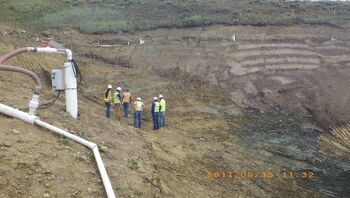Dewatering: Difference between revisions
No edit summary |
No edit summary |
||
| (One intermediate revision by the same user not shown) | |||
| Line 5: | Line 5: | ||
{{Picture | {{Picture | ||
<!-- Add image file name (ex.image.jpg) --> | <!-- Add image file name (ex.image.jpg) --> | ||
|image= | |image= DewateringWellSystem.JPG | ||
<!--Add link if applicable --> | <!--Add link if applicable --> | ||
|link= | |link=https://damtoolbox.org/images/4/47/DewateringWellSystem.JPG | ||
<!-- Add picture caption --> | <!-- Add picture caption --> | ||
|caption= | |caption=Dewatering well system to allow excavation at dam toe while reservoir storing water. | ||
(Image Source: | (Image Source: Colorado DWR]) | ||
}} | }} | ||
Latest revision as of 17:26, 7 May 2024

|
| Dewatering well system to allow excavation at dam toe while reservoir storing water.
(Image Source: Colorado DWR]) |
"Construction of many conventional water projects such as dams, dikes, canals, siphons, and pumping plants requires some degree of excavation, which often extends below the local water table. The excavation can be an expensive operation, depending on the required depth, subsurface materials, and groundwater conditions. Water Removal and Control (WR&C) systems are often employed along with other techniques such as unwatering methods and/or cutoff walls in controlling the water and seepage within and surrounding the excavations. WR&C systems can be constructed by a variety of methods, either singly or in combinations, to effectively remove and control groundwater to facilitate excavation and construction activities 'in the dry' and to maintain stability of excavated slopes. Effective WR&C systems are also important to construction scheduling and safety of the construction crews, downstream populations and infrastructures, and the safety of the embankment dam itself."[1]
"Design of WR&C systems should rely as much on experience as on the theory and calculations. Each site is unique, and no two systems will be exactly alike. Additionally, there is no one correct design, although some designs may be more applicable than others to specific site conditions. A well-suited design may include multiple features employing different technologies and configurations to achieve the desired goals."[1]
Best Practices Resources
Citations:
Revision ID: 7874
Revision Date: 05/07/2024
